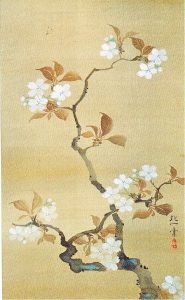![]() For ikebana “enthusiasts”
For ikebana “enthusiasts”![]()
As mentioned previously, the compositional rules of ikebana represent religious-philosophical symbols.
“Westernization” only enhances the aesthetic aspect of ikebana while at its origin, although this aesthetic aspect was important, the understanding of its symbolic content was a basic part of it.
TAOISM

Taoism classifies reality according to a binary system in which the opposing forces yang and yin are complementary and interdependent. Each of them contains the germ of the other, and they are constantly changing. This is characterised by phases of yang expansion, and yin contraction, followed by phases of yin expansion, with a concomitant yang contraction. This system is represented by the symbol of Taiji (or Taijitu).
This Taoist symbol can be found in ikebana since its first codified form – the Tatebana – and is even more evident in Rikka arrangements, which represents the Mount Sumeru (also Meru) with its yang side in the sun and its yin side in the shade. See art. 22
The Rikka, very complicated to perform, during the first half of the Edo period was simplified into the Seika/Shoka, leaving only three main elements, elements that we find unchanged in the Moribana and Heika styles of the Ohara School.
In all the articles of this blog, for the theory explanations about Rikka we refer to the Shoka/Seika which has kept the basic structure of Rikka but it is much more simple and therefore easier to explain.
One of the symbolic representations in ikebana was the union between heaven and earth expressed by placing the three main elements of Rikka and Shoka on the symbolic Taoist line that joins heaven to earth
In order to understand the reason for the symbolic spatial arrangement of the plants in ikebana, it is necessary to understand the graphic representation of the Taijitu, its orientation and its symbolic relationship with the cardinal points of the compass.
Construction of the Taijitu
:

Two circles with diameters that equal the radius of the circle that contains them are drawn inside the circle that represents “the Whole”.
They are characterised by ‘opposite’ colours :
– yang colours, such as white or red (the colours of light or of the sun) in one of the two circles. The other is coloured with
– yin colours, “opposite” to those used in the other circle, such as black or blue.
So the white circle represents the yang side and the black circle the yin side.

In the centre of the two circles the colour of the opposite circle is left to emphasise that there is neither pure yang nor pure yin
To emphasise the fact that the two energies yang and yin are always in motion and are continually transforming one into the other, one extends the white and the black (indifferently to one or the other part of the sides that surround the two circles), but the yang part will remain the half of the great circle in which the white circle is inserted (completely white quadrant + quadrant with white semicircle and black “tail”) and not the one with the greater surface of white; the same is true for the yin part.


The Taijitu is positioned in different ways in many texts: the correct one, which associates it with the cardinal points and on which the construction of an ikebana is based, is only the one drawn above; the two examples shown below are not correct because not connected with the cardinal points.
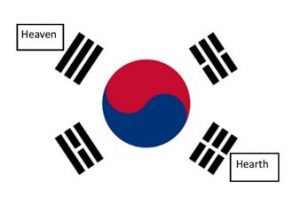
South Korean flag
The correct placement of the taijitu, in order to understand the symbolism of ikebana and its relationship to the cardinal points, can be seen in the South Korean flag above: the important thing is the position of the coloured circle (and not its tail) red-yang towards the sky and blue-yin towards the earth.
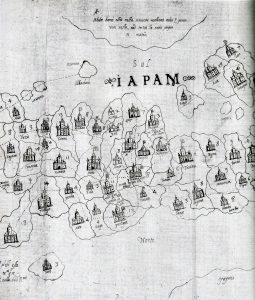
Unlike the modern Western convention of putting north at the top and south at the bottom, in China, and consequently in Japan, people put south at the top and north at the bottom because the sun, in reality and when it is at its peak, associated with the south, is high above our heads and not below.
.
Above you can see a map of Japan with Portuguese inscriptions, dated 1585, where you can see that the south (SUL) is at the top above the inscription IAPAM, while the north (NORTE) is visible at the bottom
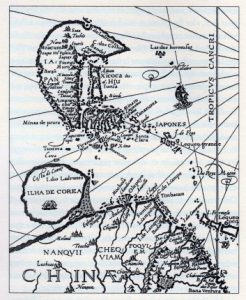
Above you can see a map of Japan with Portuguese inscriptions, dated 1585, where you can see that the south (SUL) is at the top above the inscription IAPAM, while the north (NORTE) is visible at the bottom
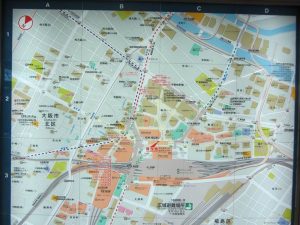
The south at the top and the north at the bottom is also found today on the underground maps of Japanese cities, as in this example of Osaka city. m
We also find the south at the top in this medieval European cartography, see Tabula Rogeriana, the world map drawn by Brother Mauro and others
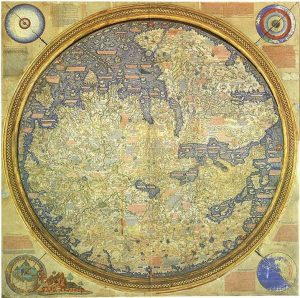
Above is above mentioned world map dated 1440 – kept in Venice.
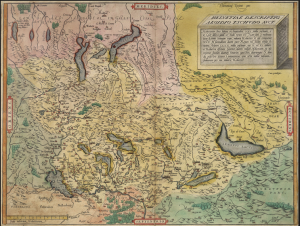
Map dated 1584 of the region of present-day Switzerland in which the lakes of Como (Larius), Lugano and Locarno (Verbanus) are at the top marked MERIDIES and German-speaking Switzerland is drawn to the north, at the bottom marked SEPTENTRIO below Basel, Switzerland’s northernmost city, and the Rhine River.
.
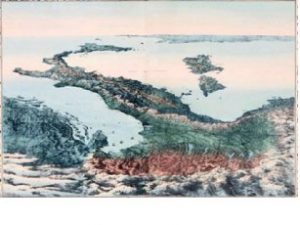
We see the Taijitu from the north, as if we were looking at Italy from the north, so just as the sun/south, in relation to us looking, is high above Italy, so too in the Taijitu the sun/south is positioned at the top.
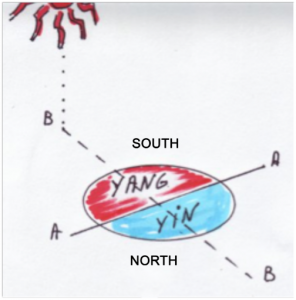
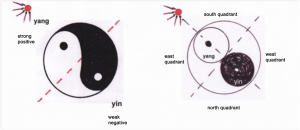
Another difference between East and West is that in the West we consider the cardinal orientations north, west, south, east, whereas in the East they consider the entire quadrants north, west, south, east.
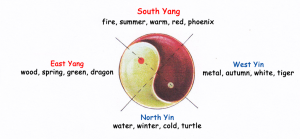
Looking at the Taijitu we see that the southern quadrant, at the top, is yang, associated with fire, summer, the colour red, the phoenix (see 9th article).
If the south quadrant is yang, the north quadrant at the bottom is yin and is also associated with the “opposites” listed in the yang/south quadrant, which are: cold, water, winter, the colour black, the turtle.
Following the same logic we make the other combinations: the sun is born in the East and its light and heat increase, grow: the increase/growth is therefore a yang characteristic so this quadrant is considered yang, while the sun sets in the West, it weakens and the weakening is a yin characteristic so this quadrant is considered yin: in both quadrants we have associations with the elements, seasons, colours, protective animals and more.
We then have the circle of the Taijitu divided in two parts: yang (south and east quadrants) and yin (north and west quadrants) separated by a line A-A, inclined at 45° in relation to the observer and perpendicular to the line B-B, which unites the point of maximum-yang, where the sun is symbolically placed, with the point of maximum-yin. This line is also inclined at 45° in relation to the viewer.
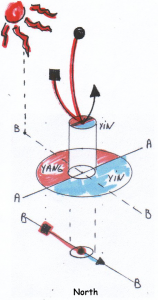 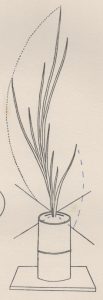 |
Let us imagine drawing the symbol of Taiji on a table. The sun, which in western representations is positioned to the south, in oriental symbolism is positioned between the two east/south quadrants, at the point considered as maximum-yang. We look at the Taijitu from the north and the sun is behind the drawing, symbolically positioned on the line perpendicular to point B (maximum yang).
Since the Rikka is composed by many vegetal elements and its construction is difficult to be interpreted, for the explanations and to highlight the symbolic position of the vegetals I use the scheme of the Shoka, (simplification of the Rikka, with only the three main elements named by the Ohara school shu, fuku and kyaku). We see that these three main elements are all lined up along the BB line which symbolically represents the union between sky/sun. The sun is at the point of maximum yang and the earth is at the point of maximum yin. All this is evident in the Rikka and Shoka of the Ikenobo school. |
Each school of ikebana names the three main elements differently. It is customary to graphically indicate the main element (the shu of the Ohara school) with a circle, the second element (the Ohara fuku) with a square and the third element (the Ohara kyaku) with a triangle (but unfortunately not everyone follows this rule).
Please also note that the two main elements shu/fuku are on the yang side, in red in the diagram, while kyaku is on the yin side, in blue: consequently the plant material used for shu and fuku must be yang compared to the one used for kyaku. This is the reason why, still today in the Ohara school, in the traditional styles, the shu-fuku group is composed of Ki-wood material while the kyaku group is composed of Kusa-“grass” material,( see 2nd article “concept of strong and weak” )
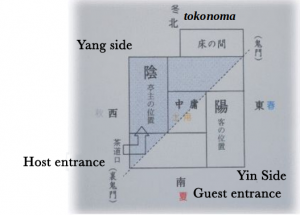
It is interesting to know that also the space of Sen no Rikyu’s wabicha is divided into yang and yin sides like ikebana.
The above layout shows the subdivision of the 4 and a half tatami space dedicated to Chanoyu with the yang side where the host is positioned and the yin side where the guests are accommodated
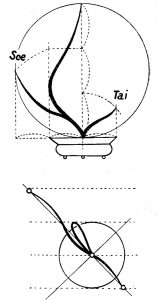
In this diagram of Shoka, seen both from the front and from above, the symbolic sky-earth direction assumed by the three main elements in alignment is clearly visible:
the highest central element (the Ohara school shu): it starts from the centre, goes towards the sun and comes back towards the centre so that its tip stays on the orthogonal of the starting point
Soe (fuku Ohara school): goes towards the sun
Tai (kyaku Ohara school): goes towards the earth.
It is also evident that shu and fuku are on the yang side of the composition while kyaku is on its yin side.
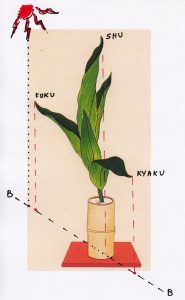
You can see above the drawing of a Shoka Ikenobo made of only Aspidistra leaves: as in the scheme described above, shu and fuku are directed backwards to the left (towards the symbolic position of the sun at the maximum yang point of the taiji on our left) while kyaku is directed towards our right, forward, in the symbolic direction towards the earth at the maximum-yin point.
Along the BB line only the three main elements are aligned while their auxiliaries all assume different directions both backwards as well as in all other directions.
Another important rule (see art. 24) originating from Shinto is that:
shu looks towards the sun while all the other plants look towards shu.
In the drawing with Aspidistra it is clearly visible that the positive/yang/dark side of the leaves follows the above-mentioned rule and we see the composition, as a whole, from the north, “from behind”, as it faces the sun, positioned for the rikka and shoka of the Ikenobo School on the other side of the vase from us looking at it.
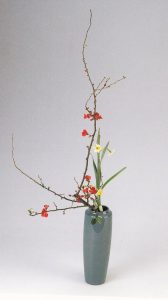
When only one plant species is used, as in the case with the aspidistra, it cannot be emphasised that the shu-fuku group, on the yang side, must be composed of “stronger” plants than the plants of the kyaku group, on the yin side of the composition.
This difference is evident in the Heika hongatte above in which the shu-fuku group, being on the yang side, is “stronger” wood material than the material used for the kyaku group, flowers which are yin, i.e. “weaker”, than the wood material of the shu-fuku group.
During the Tokugawa period, Neo-Confucianism was preferred to Taoism, for which symbolically the Heaven is above and the position of the sun was changed from “behind” to ” the front” of the composition on the same side as the viewer of the ikebana and consequently also the direction of the three main elements was changed: the composition was called Seika.
| Shoka | Seika Seika |
Seika |
 |
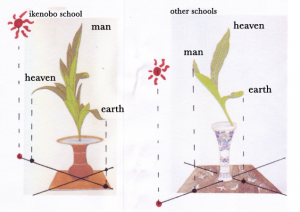 |
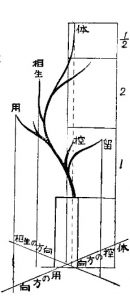 |
I
The only school that maintained the Taoist symbolism and did not change the directions of the three main elements was the Ikenobo, who called the composition Shoka.
The three main elements of the composition symbolically connecting heaven to earth remained in Seika but was expressed in a different way. Changing from Taoist symbolism (yang-yin) to the symbolism of neo-Confucianism (preferred by the Tokugawa to Taoism) the position of the elements therefore changed
 |
Looking from top to bottom in Seika (neo-confucianism) the heaven is at the top, the earth is at the bottom and the man between these two while in Shoka we find man, then heaven and hearth.
Furthermore: -in Shoka, based on the Taoist scheme, this symbolic union is given by the alignment of the three elements on the BB axis where we find: fuku = sky, shu = man, kyaku = earth. — in Seika, based on the scheme of neo-Confucianism, this union is from top to bottom, so that the highest element is called heaven and consequently the intermediate element is called man, while the lowest element remains the earth (shu=heaven, fuku=man, kyaku=earth). see also art. 24: shinto and ikeba |



